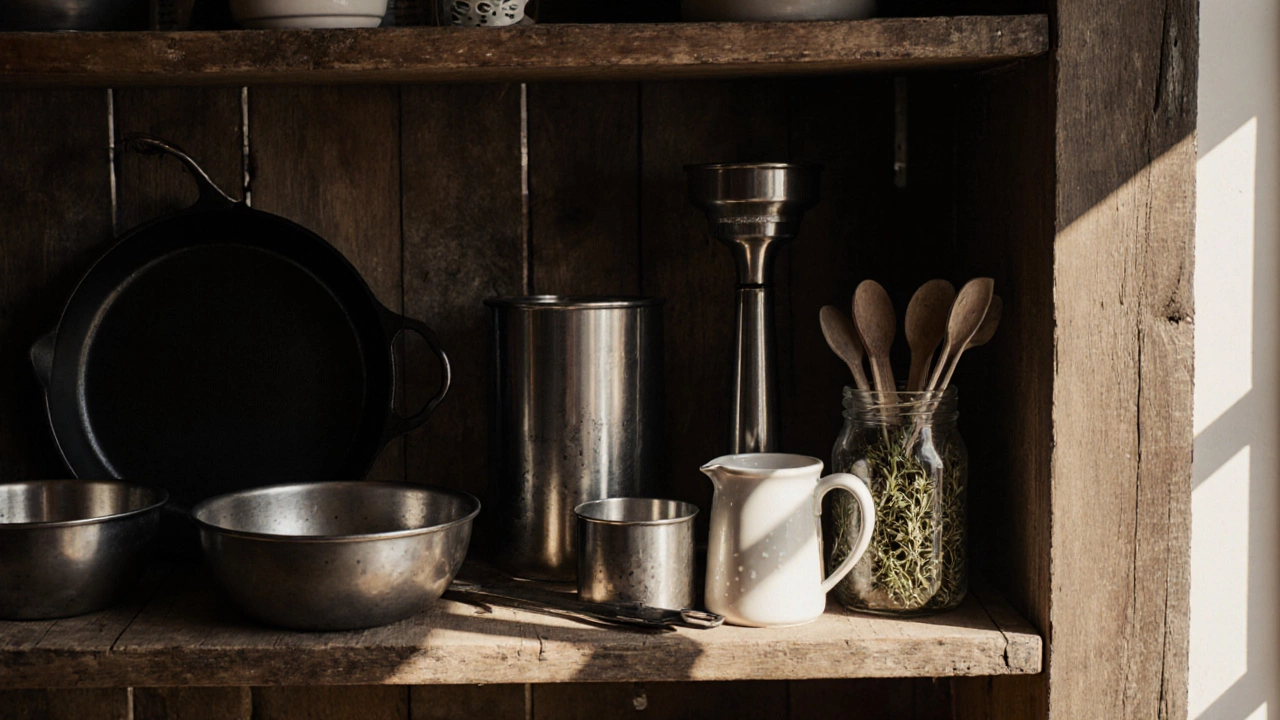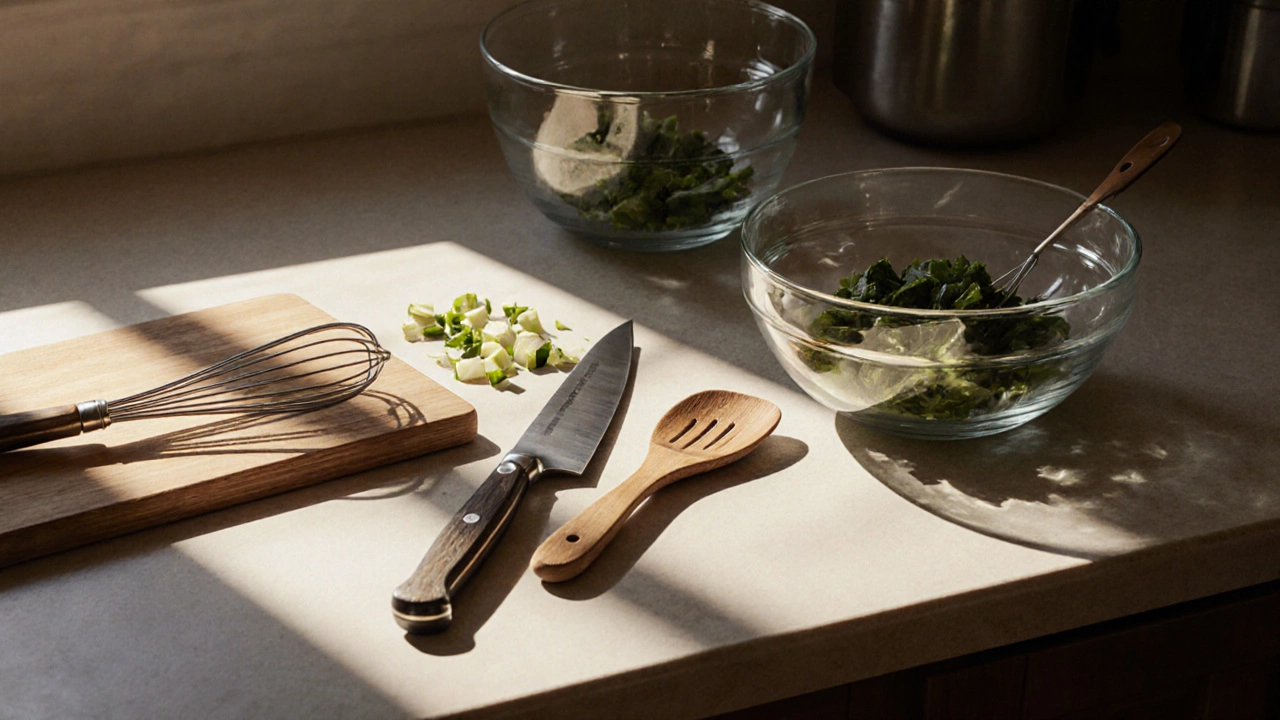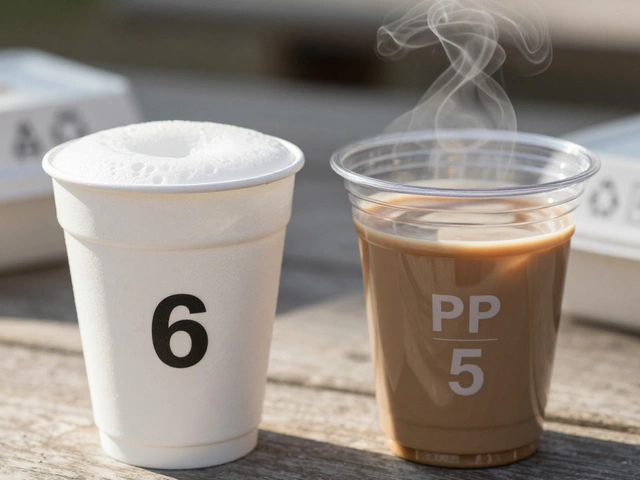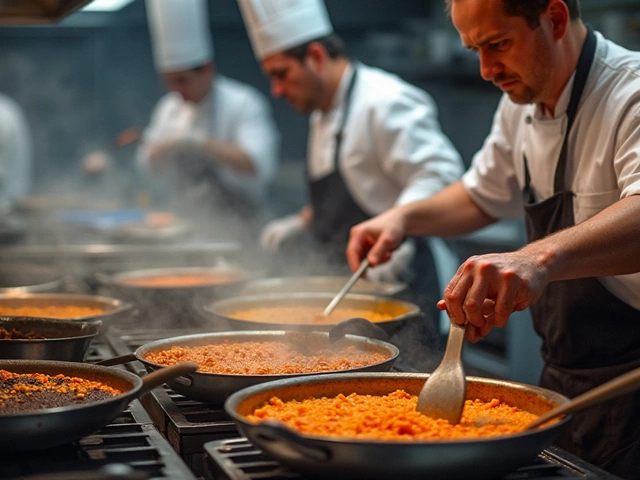When you walk into a kitchen, what do you see? Pots, spatulas, knives, measuring cups, colanders - all of these are kitchenware. But what does that word actually mean? It’s not just fancy cookware or expensive gadgets. Kitchenware is everything you use to prepare, cook, serve, and store food in your kitchen. It’s the tools that turn raw ingredients into meals, and it’s often the difference between a stressful night in the kitchen and a smooth, satisfying cooking experience.
Kitchenware Isn’t Just Pots and Pans
Many people think kitchenware means only the big stuff - the pots, the pans, the oven. But that’s only part of it. Kitchenware includes everything from the wooden spoon you stir soup with to the silicone baking mat you put under cookies. It’s the can opener stuck in the drawer, the citrus zester you forgot you owned, and the glass mixing bowls you use every Sunday for pancakes.
Think of it this way: if it touches your food during preparation or serving, and it’s not part of the appliance or the building, it’s kitchenware. That includes:
- Utensils: spatulas, tongs, whisks, ladles, peelers
- Containers: storage jars, food wrap, airtight bins
- Measuring tools: cups, spoons, kitchen scales
- Prep tools: cutting boards, graters, garlic presses
- Serving items: plates, bowls, serving spoons, napkin holders
- Small appliances: manual can openers, hand mixers, coffee grinders
Even a simple rubber band holding your herbs together in the fridge counts. Kitchenware is the quiet, everyday heroes of your kitchen.
Why Kitchenware Matters More Than You Think
Good kitchenware doesn’t just make cooking easier - it changes how you feel about cooking. If your knife is dull, chopping onions feels like a chore. If your measuring cup is cracked, you guess ingredients and wonder why your cake turned out weird. If your spatula melts in the pan, you start dreading Sunday brunch.
Research from the University of California, Berkeley found that people who used well-designed, durable kitchen tools cooked more often and ate healthier meals. Why? Because the right tools remove friction. When you don’t fight your equipment, you’re more likely to try new recipes, cook from scratch, and enjoy the process.
It’s not about buying the most expensive set. It’s about having tools that fit your hands, work reliably, and last. A $15 stainless steel spoon that doesn’t bend or melt will outperform a $40 plastic one that warps after three uses.
What’s Not Kitchenware?
It’s easy to get confused. So what doesn’t count?
Large appliances like refrigerators, ovens, microwaves, and dishwashers aren’t kitchenware. They’re kitchen appliances. Kitchenware is the handheld, non-electric, non-built-in items you pick up and use directly. A stand mixer? Appliance. A hand whisk? Kitchenware. A toaster? Appliance. A bread knife? Kitchenware.
Also, ingredients aren’t kitchenware. Flour, salt, olive oil - those are food. The container you store them in? That’s kitchenware. The scoop you use to measure them? Also kitchenware.
This distinction matters because when you shop or organize, you’re dealing with two different categories: big machines you plug in, and small tools you hold. Mixing them up leads to cluttered drawers and wasted money.

Materials Matter: What Your Kitchenware Is Made Of
Not all kitchenware is created equal. The material affects safety, durability, and even taste.
- Stainless steel is the most common for pots, pans, and utensils. It doesn’t react with food, lasts decades, and is dishwasher-safe.
- Wood is gentle on non-stick surfaces and doesn’t scratch. Great for spoons and cutting boards, but needs occasional oiling.
- Silicone is heat-resistant and flexible. Perfect for spatulas and baking molds. Look for food-grade silicone - cheap versions can leach chemicals.
- Cast iron is heavy but unbeatable for searing and baking. Needs seasoning but can last generations.
- Plastic is cheap but melts easily and can harbor bacteria. Avoid using it for hot food or high-heat tasks.
- Glass is inert and great for storage. Easy to clean, but breaks if dropped.
Many people buy kitchenware based on looks - colorful silicone spatulas, trendy ceramic bowls. But function should come first. A plain stainless steel spoon might not look Instagram-worthy, but it’ll outlive three trendy spatulas.
How to Build a Basic Kitchenware Kit
You don’t need 50 tools to cook well. Start with these 12 essentials:
- chef’s knife
- cutting board
- wooden spoon
- silicone spatula
- metal whisk
- colander
- measuring cups and spoons
- can opener
- mixing bowls (glass or stainless steel)
- baking sheet
- saucepan with lid
- storage containers (glass or BPA-free plastic)
That’s it. You can make almost any meal with these. Add more only when you have a clear need - like a garlic press if you use garlic daily, or a microplane if you zest citrus often.
Buy one thing at a time. Don’t fall for the 100-piece kitchen sets sold in malls. Most of those items sit unused. Focus on quality over quantity. A single good knife is worth more than a drawer full of cheap ones.

Where Kitchenware Fits in Your Life
Kitchenware isn’t just about cooking. It’s about rhythm. The clink of a spoon in a bowl. The smell of garlic sizzling in a pan. The satisfaction of wiping down a clean cutting board after dinner.
For families, kitchenware becomes part of tradition. The wooden spoon passed down from a grandparent. The mismatched plates from a thrift store that became the family’s favorites. The chipped mug used only for morning coffee.
It’s also about sustainability. Choosing durable kitchenware means fewer replacements, less waste. A stainless steel strainer lasts 20 years. A plastic one lasts two. That’s not just省钱 - it’s smarter living.
In New Zealand, where many households cook with local ingredients - fish from the coast, lamb from the hills, seasonal vegetables from the garden - having reliable kitchenware makes a real difference. You don’t want a flimsy grater when you’re peeling kumara for Sunday roast.
Common Mistakes People Make
Here are the top three mistakes with kitchenware:
- Buying too much too soon. You don’t need a garlic press on day one. Wait until you’re using garlic every week before you buy it.
- Ignoring maintenance. Cast iron needs seasoning. Wooden spoons need oil. Knives need sharpening. Neglecting care shortens life.
- Using the wrong tool for the job. Don’t use a plastic spoon to stir boiling pasta - it’ll melt. Don’t use a knife to scrape a pan - you’ll dull it. Use the right tool, and it’ll last.
Also, don’t store everything in one drawer. Group similar items. Keep utensils near the stove, measuring tools near the counter, and storage containers near the fridge. Organization saves time and reduces frustration.
Final Thought: Kitchenware Is the Quiet Heart of Your Home
Kitchenware doesn’t shout. It doesn’t have a brand logo on every piece. But it’s the reason your meals turn out right, your kitchen stays clean, and your time in the kitchen feels peaceful. It’s not about having the latest gadget. It’s about having tools you trust.
Start with a good knife. Add one tool at a time. Choose materials that last. And remember - kitchenware isn’t just what you use to cook. It’s what helps you care for your family, one meal at a time.
Is kitchenware the same as cookware?
No. Cookware refers specifically to pots, pans, and baking dishes used for cooking on the stove or in the oven. Kitchenware is broader - it includes cookware plus utensils, storage containers, measuring tools, and serving items. So all cookware is kitchenware, but not all kitchenware is cookware.
Do I need expensive kitchenware?
No. Expensive doesn’t mean better. A $5 stainless steel spoon from a local hardware store can outperform a $50 branded one if it’s made well. Focus on material, weight, and how it feels in your hand. Look for solid construction, not a fancy logo.
What kitchenware lasts the longest?
Stainless steel, cast iron, and high-quality wood last the longest. Stainless steel utensils and pots can last 30+ years with basic care. Cast iron skillets, when seasoned properly, can be passed down through generations. Wooden spoons, if oiled regularly, last decades too.
Can plastic kitchenware be safe?
Only if it’s labeled food-grade and BPA-free, and only for cold or room-temperature use. Avoid plastic for hot food, microwaving, or high-heat tasks. Heat can cause chemicals to leach into food. Glass or stainless steel are safer for storage and heating.
How often should I replace my kitchenware?
Replace tools when they show damage or wear that affects safety or function. A cracked cutting board, a warped spatula, or a chipped knife blade should be replaced. Otherwise, good kitchenware doesn’t need replacing - just maintenance. Many people replace things out of habit, not need.







